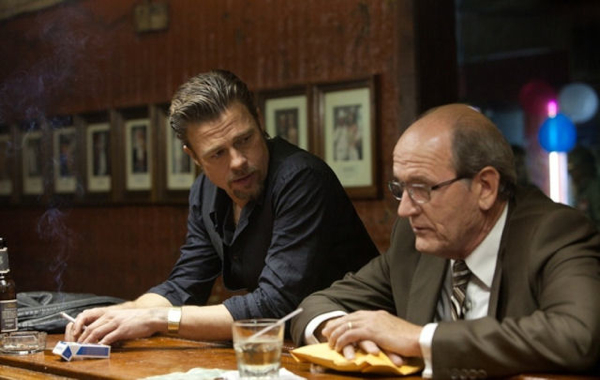Movie review by Greg Carlson
Hard-boiled crime fiction writer George Higgins’s 1974 novel “Cogan’s Trade” is the basis for writer-director Andrew Dominik’s self-conscious genre entry “Killing Them Softly,” a jazzy acting showcase that embraces both the crime-as-business and style-above-all dicta that have steered gangster movies since the birth of the form. Brad Pitt is comfortable as a calm, exacting mob enforcer hired to clean up the mess resulting from a card game robbery. The actor reteams with Richard Jenkins and James Gandolfini, two previous co-stars whose presence instantly increases the aggregate performance I.Q. of the cast.
Pitt, whose interest in working with Dominik helped secure financing for “The Assassination of Jesse James by the Coward Robert Ford,” is more relaxed and arguably better when playing the morally compromised antihero. His best scenes in “Killing Them Softly” are the ones in which he discusses strategy with Jenkins’ suit-and-tie messenger and recognizes the error of bringing in Gandolfini’s no longer competent muscle. Gandolfini’s grotesque is riveting, and as soon as he appears on screen, Dominik downshifts the pace, accommodating the actor’s formidable skill in a manner not unlike the way Peter Yates appreciated Robert Mitchum in “The Friends of Eddie Coyle,” another film adapted from a George Higgins book.
Dominik’s least necessary update to Higgins – and really the only deliberate indication that the movie could not take place in the 1970s – moves the action to 2008. Televisions and radios playing soundbites from George W. Bush and Barack Obama highlight the sense of impending economic doom descending on America’s poor and working class. Unlike the similar “recent period” tactic employed by the Coens in “The Big Lebowski,” however, Dominik does not know when to quit, and the unsubtle motif wears out its welcome soon after the slick, arrestingly sound-designed opening title sequence.
The worlds Dominik chooses to investigate pulse with testosterone and masculinity. There is little room here for women and the only female with a significant speaking role in “Killing Them Softly” is Linara Washington’s degraded prostitute, who appears in a brief exchange with Gandolfini’s coarse alcoholic. The absence of women signals many things, but chief among them may be the failure of the corporate model Dominik explores via crime metaphor. That women are so invisible as human beings in the realm of wiseguys, driven as it is by unrelenting physical violence, is not particularly surprising. Dominik’s reliance on the misogyny cultivated in the filthy talk of Higgins’ ugly brutes, is, however, problematic.
Alongside the bleak, shabby, industrial environments inhabited by the lowlifes and outcasts who populate Higgins’ imagination, a crafty sense of very black comedy accompanies the unsavory felonies. Dominik cited “Blue Velvet” as one of his favorite movies in the “Sight & Sound” “greatest films poll” coverage this year, and the influence of David Lynch’s noir masterpiece is in evidence during a slow-motion, rain-soaked hit underscored by Ketty Lester’s “Love Letters.” Less overtly, Lynch’s gallows humor weltanschauung leaves its mark on what may be Dominik’s saving grace. With the exception of Pitt’s savvy operator Jackie Cogan, who knows how to get paid, the denizens of “Killing Them Softly” are hapless and hopeless underclass goons ready to be sacrificed for their foolishness.
